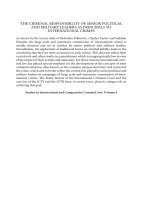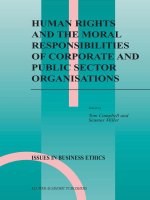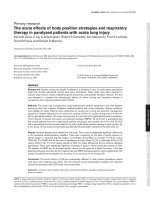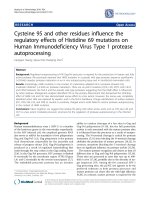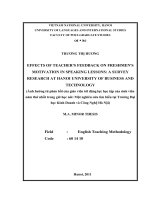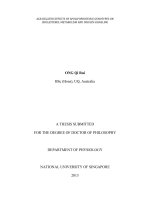The contingent effects of corporate political strategies on firm outcomes
Bạn đang xem bản rút gọn của tài liệu. Xem và tải ngay bản đầy đủ của tài liệu tại đây (1.79 MB, 123 trang )
i
THE CONTINGENT EFFECTS OF CORPORATE
POLITICAL STRATEGIES ON FIRM OUTCOMES
ZHENG YAN
(B.A. in Management, Fudan University)
A THESIS SUBMITTED
FOR THE DEGREE OF DOCTOR OF MANAGEMENT
DEPARTMENT OF STRATEGY AND POLICY
NATIONAL UNIVERSITY OF SINGAPORE
2014
ii
DECLARATION
I hereby declare that the thesis is my original
work and it has been written by me in its entirety.
I have duly acknowledged all the sources of
information which have been used in the thesis.
This thesis has also not been submitted for any
degree in any university previously.
ZHENG YAN
31 October 2014
iii
ACKNOLEDGEMENTS
The doctoral dissertation is an enormously painful yet uniquely rewarding
journey replete with unforgettable moments when I kept pushing my intellectual,
physical, and emotional limits. Along this journey, I could not have been
anywhere near the finish line without the tremendous help that I have received
from my dissertation committee members Professors Sea-Jin Chang, Ivan Png,
and Markus Taussig.
I owe most thanks to my dissertation committee chair and advisor Professor
Sea-Jin Chang for the rigorous academic training that has transformed me from an
inexperienced graduate student into an independent scholar. His consistently high
expectations and confidence in me have kept me stretching myself to be the best I
could be. Through the years, his uncompromised high standards for research have
demonstrated to me what it takes to pursue true scholarship. I owe particular
gratitude to Professor Ivan Png, who pulled me through perhaps the most difficult
time in my dissertation work when I felt stuck in a rut and started to doubt if I
could ever finish. The invaluable mentorship I have received from him helped me
think and understand what it takes to be not only a great researcher, but, more
importantly, a great person. I am also truly grateful for the enormous help from
Professor Taussig. As a junior faculty member on my committee, he has always
been uniquely well positioned to understand the tough situations I was in and
guide me through them.
iv
I am also deeply indebted to the generous guidance from people outside my
committee including but not limited to Professors Jie Gong, Kulwant Singh, and
Will Mitchell. They spent numerous hours out of their busy schedule providing
invaluable comments and advice on various versions of my dissertation.
I would also like to extend my thanks to the excellent administrative service
from Teo Woo Kim, Azlina Kasmari, Fatimah Rasheeka, and Jenny Chng. The
supportive environment they have created provided me the access to essential
administrative resources. My heartfelt appreciation also goes to my best
companions and friends Don Jia Qing Chen, Gregory Dunn, Zen Wan Chen Goh,
Shuping Li, and Toshimitsu Ueta. They have accompanied me through the tears
and laughter. The friendship we have built over the years has been what keeps me
cheerful and optimistic and makes my years at NUS memorable.
Finally and foremost, I want to thank my parents and sister for their
unconditional love and invaluable guidance in my life. Words cannot describe my
gratitude. I dedicate my work to them.
v
TABLE OF CONTENTS
ACKNOLEDGEMENTS iii
SUMMARY vi
LIST OF TABLES ix
CHAPTER 1: BOON OR BANE? THE CONTINGENT EFFECTS OF POLITICAL
STRATEGIES ON FIRM PERFORMANCE 1
ABSTRACT 1
INTRODUCTON 2
THEORY AND HYPOTHESES 6
METHODS 18
RESULTS 33
DISCUSSION AND CONCLUSION 43
CHAPTER 2: THE SIGNALING VALUE OF POLITICAL STRATEGY: PUBLIC
PATRONAGE AND FIRMS’ ACCESS TO EXTERNAL RESOURCES 55
ABSTRACT 55
INTRODUCTION 56
THEORY AND HYPOTHESES 59
METHODS 69
RESULTS 79
DISCUSSION AND CONCLUSION 88
REFERENCES 108
vi
SUMMARY
This dissertation consists of two studies to investigate the contingent effects
of corporate political strategies on firm outcomes. To address this theoretical
inquiry, I examine (a) firms’ political connections built through managerial
political service and (b) public patronage in the form of public visits to firms by
government officials, and their effects on firm performance and access to external
resources. I theoretically propose and empirically find the important contingencies
that impact the relationships between political strategies and firm outcomes,
including (a) the structural relations among political actors who share authority in
the political system and (b) political actors’ discretion over the allocation of
resources in markets. As such, this dissertation contributes to a complete,
comprehensive, and contingent perspective on the effects of corporate political
strategies.
In particular, the first study examines both the positive and negative
performance effects of firms’ political strategies, contingent upon the structural
relations among political actors sharing power in the government. I propose that
while firms’ connections with the focal political actor that possesses the main
authority over the business activity pursued by the firms enhance firm
performance, firms’ connections with rival political actors who compete with the
focal political actor hurt firm performance. Moreover, the magnitude of the
negative effect varies with the competitive tension between these political actors.
vii
Finally, I argue that firms can strategically neutralize the harms stemming from
their connections with rival political actors by building connections with a
constraining political actor who lies outside the rival dyad and has the ability to
limit the focal political actor’s behavior. The empirical analysis employing data
on acquisitions by Chinese steel firms during the industry’s consolidation from
1999 to 2010 supports the theory.
The second study proposes an indirect signaling mechanism through which
political strategies generate value for firms. This study suggests that public
patronage in the form of public visits to firms by government officials provides
signals on the firms’ quality, government favor, and/or legitimacy to third-party
resource holders, which in turn facilitate the firms’ access to external resources.
More importantly, while prior research suggests diminished value of political
strategies generated through direct mechanisms under less government
intervention in markets, I argue that the signaling value of public patronage
increases when the government has less control over the resource markets. Results
based on a unique dataset that comprehensively covers public visits by
government officials to Chinese steel firms during 1995–2009 confirm these
arguments.
In addressing the core research question regarding the contingent effects of
political strategies on firm outcomes, this dissertation advances the literatures on
viii
corporate political strategies, competitive dynamics, and interorganizational
endorsements.
ix
LIST OF TABLES
Table 1.1 49
Table 1.2 50
Table 1.3 52
Table 1.4 53
Table 2.1 94
Table 2.2 95
Table 2.3 96
Table 2.4 98
Table 2.5 99
Table 2.6 101
Table 2.7 102
Table 2.8 104
Table 2.9 106
1
CHAPTER 1: BOON OR BANE? THE CONTINGENT EFFECTS OF
POLITICAL STRATEGIES ON FIRM PERFORMANCE
ABSTRACT
This paper examines the positive and negative performance effects of firms’
political strategies, contingent upon the structural relations among political actors
within the government. Drawing upon corporate political strategy literature and
the competitive dynamics perspective, this paper shows that, while firms benefit
from their connections with the focal political actor that possesses the main
authority over the business activity pursued by them, firms suffer from their
connections with rival political actors who compete with the focal political actor.
Moreover, the magnitude of the negative effect varies with the competitive
tension between these political actors. To neutralize the negative effect, firms can
strategically turn to a constraining political actor outside the rival dyad that
possesses the ability to limit the focal political actor’s behavior. Analyses on the
acquisitions conducted by Chinese steel firms during 1999–2010 confirm the
theory.
2
INTRODUCTON
Researchers are increasing their attention to corporate political strategies and
their performance effects (Hillman, Keim, and Schuler, 2004; Jia, 2014). While
prior research discusses the benefits accrued from political strategies, empirical
evidence has documented positive, negative, and no relationships between
political strategies and firm performance (Hadani and Schuler, 2013). Recent
studies suggest the effectiveness of political strategies depends on the government
structure, such that political strategies targeted at a political actor may provide
only limited benefits if this political actor is constrained by other political actors
in the government (Kozhikode and Li, 2012; Macher and Mayo, 2012). Despite
these insights into the varying degrees of positive effects of political strategies,
prior research remains largely silent on whether and under what conditions the
structural relations between political actors may negatively impact firms pursuing
political strategies, and even more importantly, how these firms can cope with
such negative effect. To answer these questions, this paper draws upon corporate
political strategy literature (Hillman and Keim, 1995) and the competitive
dynamics perspective (Chen and Miller, 2012; Yu and Cannella, 2007) to
investigate both the positive and negative performance effects of political
strategies by focusing on the structural relations between power-sharing political
actors in the government, particularly political rivals.
3
Competitive dynamics theory analyzes the antecedents, consequences, and
competitive contexts of rival behavior. Prior research has identified three
underlying drivers of competitive activity: the rivals’ awareness, motivation, and
capability (AMC) (Chen, 1996; Yu and Cannella, 2007). While competitive
dynamics research has largely focused on inter-firm rivalry, emerging research
has begun to extend beyond firm dyads and analyze rivalry at other levels
(Kilduff, Elfenbein, and Staw, 2010). As such, Chen and Miller (2012) point to
the applicability of the competitive dynamics perspective to explain relationships
between any actors or entities other than firms. In this study, I employ
competitive dynamics theory to examine how structural relations among political
actors influence their awareness, motivation, and capability, which in turn affect
their behavior toward firms pursing political strategies. I propose that while firms
connected with the focal political actor — the political actor that possesses the
main authority to facilitate or hinder the business activity pursued by the firms —
reap performance gains, firms connected with rival political actors that compete
with the focal political actor suffer performance loss. Moreover, the magnitude of
the negative effect depends on the competitive tension between the focal and rival
political actors, which is driven by the similarity between and the salience of the
political rivals. Finally, to neutralize this negative effect, firms can act
strategically to take advantage of the structural relations in the government by
4
turning to a constraining political actor that lies outside the rival dyad and has the
ability to limit the focal political actor’s behavior.
The empirical analysis employs data on acquisitions by Chinese steel firms
during the industry’s consolidation from 1999 to 2010. As a regulated industry,
the steel industry remains subject to government intervention and has been used in
previous research on political strategies (Schuler, 1996). Moreover, a substantial
body of research in political economy has noted the fragmented structure of the
Chinese government, characterized by regional decentralization and inter-
jurisdictional competition (Blanchard and Shleifer, 2001; Montinola, Qian, and
Weingast, 1995). Therefore, China’s steel industry provides an ideal context to
examine the interplay among firms and political actors. This study tests the effects
of steel acquirers’ connections with local and central governments on their
performance measured with their likelihood of acquisition during the industry’s
consolidation.
This paper contributes to corporate political strategy literature (Bonardi,
Hillman, and Keim, 2005; Hillman and Hitt, 1999). First, the focus of this study
on the structural relations between political actors gives new insight into the
mixed empirical evidence in extant literature regarding the performance effects of
political strategies (Hadani and Schuler, 2013). With a contingent and
comprehensive perspective, this paper accounts for both the positive and negative
effects of political strategies. Second, this study identifies the similarity between
5
and the salience of political rivals as drivers of different levels of competitive
tension, thereby providing a fine-grained analysis on the varying degrees of
negative effects experienced by politically connected firms. Finally, this paper
suggests possible coping strategies such as turning to a constraining political actor
to limit the focal political actor’s behavior. This discussion is consistent with
emerging research that emphasizes the strategic implications of institutional
constraints on political actors (Holburn and Vanden Bergh, 2008; Kozhikode and
Li, 2012; Macher and Mayo, 2012).
This study also contributes to competitive dynamics research (Smith, Ferrier,
and Ndofor, 2001). First, this paper identifies the government as an important
stakeholder and demonstrates the applicability of competitive dynamics theory to
examine relationships between political actors. The findings are consistent with
emerging work that has begun to include a broader range of stakeholders in
addition to firms when exploring competitive dynamics (Chen and Miller, 2014).
Further, by considering politicians’ career concerns as the drivers of competitive
tension and behavior, this study corresponds to the shift of focus in competitive
dynamics research from organizational characteristics to individual motivation
and perception (Chen, Su, and Tsai, 2007). As such, this paper advances emerging
research in exploring the potential of competitive dynamics theory to bridge
macro- and micro-analyses (Chen and Miller, 2012). Finally, in line with recent
competitive dynamics research that extends beyond market boundaries (Capron
6
and Chatain, 2008; Markman, Gianiodis, and Buchholtz, 2009), this paper links
competitive dynamics perspective to nonmarket strategy literature.
THEORY AND HYPOTHESES
Contingent effects of political strategies
Government exerts substantial influence over business. Through regulations,
government can block mergers and acquisitions, cap industrial output, and adjust
labor and environmental costs (Hillman, Zardkoohi, and Bierman, 1999). In
response, firms build access to government through political strategies including
lobbying, campaign contributions, and managers’ political service to shape policy
making and access information and resources (Schuler, Rehbein, and Cramer,
2002). In emerging economies, firms use political strategies to overcome weak
legal and economic institutions. Political connections provide firms with access to
economic resources and protection from government expropriation (Li and Zhang,
2007; Peng and Luo, 2000).
A growing body of research suggests that the benefits arising from firms’
political strategies depend on the government structure. In many political systems,
power is shared among various political actors with divergent or even conflicting
interests (Ring et al., 2005). Therefore, the discretion of a political actor over
policy making and resource allocation is constrained by its relations with other
political actors. For instance, the executive branch often has less discretion under
7
presidential systems than parliamentary systems (Hillman and Keim, 1995).
Within a government, appointed regulators are constrained by the executive and
legislative branches, and their ruling decisions reflect compromise among these
different government branches (Holburn and Vanden Bergh, 2008). As such, the
effectiveness of a firm’s political strategies should depend on the discretion of the
political actor that the firm targets, in that a constrained political actor may lack
the authority to aid the firm (Macher and Mayo, 2012).
Following these arguments, a firm is only likely to gain from its political
strategies targeted at the focal political actor who possesses the primary authority
to influence the business activity pursued by the firm. Aggregating firms’ political
strategies without distinguishing the political actors that these strategies target
will obscure the effects, as political access with different political actors are
unlikely to generate the same level of benefits. In the empirical context of this
study, Chinese steel firms often rely on political connections to facilitate their
acquisitions during the industry’s consolidation. However, since the economic
reform, authority over local economic issues like acquisition approval has shifted
to local governments (Li and Zhou, 2005; Xu, 2011). Thus, only acquirers’
connections with the focal local government that governs the region where the
target is located will likely aid the acquisition. The focal local government can
provide critical information about the target, as well as facilitate regulatory
approval. For instance, Baosteel, a leading Chinese steel producer connected with
8
the central government, approached Handan Steel in Hebei Province in 2006 for
potential takeover. However, the deal did not go smoothly and Baosteel ended up
withdrawing from the negotiations. Despite the central government’s support for
Baosteel, ―much depends on the local governments, whose stance remains unclear‖
(Li, Li, and Yu, 2006).
Hypothesis 1 (H1): A firm’s connections with the focal political actor
positively affect firm performance.
When power-sharing political actors compete with one another, the effects
of a firm’s political strategies likely hinge on the interactions between these
political rivals. For instance, Bonardi et al. (2005) show that the benefits from
political strategies increase with competition between elected officials but
decrease with competition between appointed officials. More recently, Kozhikode
and Li (2012) show that regional political competition produces fewer benefits for
firms when a political challenger seeks to punish the region staying loyal to the
incumbent.
These arguments are also consistent with competitive dynamics research that
emphasizes the interdependent nature of competition, such that the performance
gains from an actor’s move can be quickly erased by the response of its rivals
(Smith et al., 2001). In particular, competitive dynamics scholars have identified
9
three underlying drivers to predict a rival’s reaction: its awareness of the
competitive move, its motivation to respond, and its capability to carry out the
response (Chen, 1996). While prior work has mostly focused on inter-firm rivalry
in the marketplace, it is reasonable to expect the notion of interdependence also
applies to nonmarket settings. When authority is shared between political actors,
firm performance depends not only on the firm’s relation with a political actor but
also on the relations between this political actor and other political actors in the
government.
More specifically, when a firm takes strategic steps to pursue a business
activity overseen by a focal political actor, the firm’s connections with a political
rival of that overseer may prompt a reaction to hold back the firm’s efforts. First,
the firm’s political connections influence the focal political actor’s awareness.
Strategic actions with high visibility tend to increase rivals’ cognizance (Chen and
Miller, 1994). Relatedly, a firm’s connections with a rival political actor will
likely make its action highly visible to the focal political actor and thereby raise
awareness. Second, the focal political actor is motivated to respond, worried that
the firm connected with a political rival will serve the rival’s interests at its
expense. In line with these arguments, Siegel (2007) finds that firms connected
with former rival regimes tend to be discriminated against by the regime currently
in power. Finally, the shared authority in the government also affords the focal
political actor the ability to respond when the business activity pursued by the
10
firm is under its oversight (Ring et al., 2005). Thus, the awareness, motivation,
and capability of the focal political actor will incline it to counter the strategic
moves by the firm connected with a rival political actor, resulting in lower firm
performance.
For instance, political economy researchers note that Chinese local
governments compete with one another on economic performance, a key factor
used by the central government to evaluate local officials and decide their
political careers (Blanchard and Shleifer, 2001; Qian and Weingast, 1997). As
such, a focal local government may be cautious about the move by a firm
connected with a rival local government to acquire a target firm in the focal
region. The focal local government may worry that the acquirer will transfer
economic resources such as investments, taxes, and jobs from the target firm in
the focal region to the rival region, which will strengthen the rival local
government at the expense of the focal local government. Hence, this acquirer
will likely encounter resistance from the focal local government toward its
acquisition. Indeed, in the empirical context of this study, it is widely reported
that the Chinese central government’s efforts to consolidate the steel industry
have met strong resistance from local governments because local governments
―which enjoy tax revenue from regional steelmakers, have had difficulties in
reaching agreements with each other‖ (Zhang, 2010).
11
Hypothesis 2 (H2): A firm’s connections with a rival political actor
negatively affect firm performance.
Intensity of political rivalry
Research on competitive dynamics suggests that intensity of rivalry varies
across pairs of rivals, and thus a pairwise comparison offers nuanced insights on
rival behavior (Chen, 1996). In particular, prior research has identified ―similarity‖
and ―salience‖ as important drivers of competitive tension (Chen et al., 2007).
Competitive tension is greater when rivals have similar resource profiles, and/or
when they perceive each other as salient competitors for resources critical to their
own capabilities. Following this research, I posit that competitive tension between
political rivals increases as the similarity between and the salience of the political
rivals increase. These propositions are also consistent with previous studies that
find rivalry intensity to be associated with resource similarity and market
commonality between rivals (Baum and Korn, 1996; Gimeno and Woo, 1996).
More specifically, similarity between political rivals influences their
awareness, motivation, and capability, which in turn drive competitive tension
and rival behavior (Chen, 1996). First, the more similar a rival political actor to
the focal political actor, the more aware the latter is of the former. Prior research
shows that competitors tend to compare their own performance with that of
similar others (Kilduff et al., 2010). Relatedly, a political actor likely focuses its
12
limited attention on those political rivals with similar profiles, as well as firms
connected to those rivals. Further, similar rivals tend to impose greater pressure
on one another, which increases their motivation to engage in competitive
response (Gimeno and Woo, 1996). Finally, rivals with comparable profiles are
more able to carry out an effective competitive response, as reactions toward
similar rivals tend to tap into established organizational routines (Chen, 1996).
The increased awareness, motivation, and capability of the focal political actor
will increase its perceived competitive tension and rival behavior and thereby
incur a greater negative effect on firms connected with the similar political rival
(Chen et al., 2007).
For instance, political careers of Chinese local officials are found to be
related to their individual attributes, such as age and party tenure (Li and Zhou,
2005; Shih, Adolph, and Liu, 2012; Xu, 2011). Top officials from a local
jurisdiction may perceive greater competitive tension posed by counterparts of a
rival jurisdiction with similar individual attributes, as they are likely to be
considered for the same promotion opportunity by the central government. In such
a situation, the focal local government officials may be particularly concerned
about transfer of economic resources from the focal region to the rival region, as
local economic performance bears heavily on the promotion decision by the
central government (Li and Zhou, 2005; Xu, 2011). As such, an acquirer
13
connected with a similar political rival will encounter greater resistance from the
focal local government toward its acquisition in the focal region.
Hypothesis 3a (H3a): The negative performance effect of the firm’s
connections with a rival political actor increases with the similarity between
the focal and rival political actors.
The intensity of political rivalry is also likely influenced by the degree to
which the focal political actor regards the rival political actor as a salient
competitor for resources critical to itself. As noted by Chen et al. (2007, p. 106),
―salience consideration‖ with respect to a rival’s strength in the resources of
strategic importance to the focal actor leads it to perceive greater competitive
tension and engage in more intensely rivalrous behavior.
These arguments are consistent with competitive dynamics research
suggesting that an actor perceives the moves by rivals with greater market
commonality as being more threatening to its own market and revenue, and thus
becomes more inclined to carry out a competitive response (Chen, 1996). For
instance, Baum and Korn (1996) show that competitors with high market overlap
compete for similar resources and engage in intense rival behavior. Kilduff et al.
(2010) find that perceived intensity of rivalry is greater between geographically
proximate rivals that compete for similar resources and identities. Relatedly,
14
Chang and Xu (2008) show that due to increased market commonality,
competition between foreign and local firms is greater in regional markets than in
the national market. Yu and Cannella (2007) find that multinationals with greater
multimarket contact carry out competitive reactions more quickly. Generally,
these studies suggest that rivals with higher market commonality are more likely
to compete head on for similar strategic resources and experience a greater
intensity of rivalry.
Competition for similar critical resources can result in rivals’ greater
awareness, motivation, and capability, which heighten the competitive tension.
Rivals vying for similar resources likely share a similar identity domain, and
therefore stay highly aware of one another’s actions (Livengood and Reger, 2010).
Further, the moves made by rivals competing for similar resources are more likely
to be labeled by the focal actor as threatening attacks on its core markets and
resources, and lead it to perceive high valence of responding (Chen and Miller,
1994). Finally, rivals relying on similar strategic resources tend to possess
comparable capabilities, which enable them to undertake a swift, competitive
response (Chen, 1996).
Therefore, a firm will likely encounter stronger obstruction from the focal
political actor when the firm is connected with a rival political actor that is
regarded as a salient competitor for critical resources. For instance, inter-
jurisdictional rivalry in China tends to be more intense between regions with
15
similar economic structures, because these regions rely on similar industries for
economic growth, tax revenue, and employment. The focal local government may
be particularly wary of firms transferring economic resources from its region to a
rival region sharing a similar economic structure. In such a situation, acquirers
connected with the rival local government will likely encounter greater resistance
in the focal region.
Hypothesis 3b (H3b): The negative performance effect of the firm’s
connections with a rival political actor increases with the salience of the
rival political actor with respect to the resources critical to the focal
political actor.
Coping strategies for political rivalry
The structural relations in a government where power is shared not only
impose challenges on firms but also provide them the opportunities to cope with
these challenges (Macher, Mayo, and Schiffer, 2011). Recent research has begun
to highlight the strategic implications of the institutional constraints on political
actors imposed by other political actors (Ring et al., 2005). For instance,
regulatory agencies operate under the oversight of the legislative and executive
branches, and their decisions are subject to judicial review (Bonardi, Holburn, and
Vanden Bergh, 2006). In a federal system, the national and subnational
16
governments are not always aligned in their rulings and federal laws often take
precedence over state laws (Kozhikode and Li, 2012). Across political systems,
the varying numbers of veto points result in different levels of constraints on
political actors’ discretion (Henisz, 2000). As such, to cope with the negative
effect from political rivalry, firms may turn to a political actor that lies outside the
political rival dyad and has the ability to constrain the focal political actor’s
behavior.
Specifically, the constraining political actor can influence the motivation of
the focal political actor. The focal political actor is likely to be concerned about
the potential reactions from a constraining political actor if its own actions sway
too far from the preferences of the constraining political actor. For instance,
regulators collect substantial evidence in support of their proposals to avoid the
potential loss of legitimacy resulting from their rulings being challenged by the
courts (Bonardi et al., 2006; de Figueiredo and de Figueiredo, 2002). Further, the
constraining political actor can weaken the focal political actor’s ability to carry
out an effective response. Holburn and Vanden Bergh (2008) demonstrate that
legislators and executives can limit regulators’ latitude in formulating and
enforcing regulatory rules. As such, a firm may strategically target a constraining
political actor to decrease the focal political actor’s motivation and ability to
engage in behavior against the firm (Chen, 1996).
